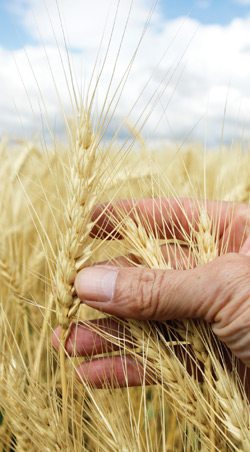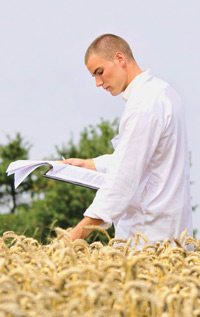
In 2014, the CFIA will begin to step away from direct delivery of pedigreed seed crop inspection. What is the path forward and how will stakeholders be affected?

The CFIA is working closely with the seed industry to ensure the smooth transition of direct delivery of seed crop inspection to the private sector. The CFIA, Canadian Seed Growers’ Association, Canadian Seed Trade Association and Canadian Seed Institute have formed a seed industry-government working group (IGWG) to develop a national framework to assist the industry in moving toward alternative service delivery of seed crop inspection. “We’re working very closely with [the seed industry] to make sure that we’re going forward with a realistic understanding of the challenges that face us. We’re taking measures to ensure that the transition will be as smooth as possible,” says Michael Scheffel, national manager of CFIA’s seed section.
Working under extremely tight deadlines, the IGWG has met more than a dozen times since last April and is making headway in its exploration of all options for ASD. “Transition to the new model is progressing fairly well,” says Scheffel. “Details for the final design of the program continue to be worked out even to this day.”
The CFIA inspection team is currently made up of 120 seasonal inspectors, who are hired over the summer months, as well as 100 full-time CFIA employees, who perform crop inspections on a part-time basis. To meet the CFIA’s budget objective, the CFIA hopes to transition the 120 seasonal inspectors to the private sector. However, CFIA inspectors will still be out inspecting seed crops in 2014. “We will be reducing our direct delivery of seed crop inspections starting in 2014, but we recognize the fact that we can’t make the switch from almost entirely official inspections to almost entirely private inspections in one crop season. It will take more than one year to transition over to the new system,” says Scheffel.
Possible Models
One of the IGWG’s major discussion points is the best model going forward for seed crop inspection. The group is currently debating the pros and cons of first-, second- and third-party inspection of seed crops. Hybrid corn, hybrid canola and a recent pilot project involving soybeans have provided examples of all three models of ASD of seed crop inspection.
For example, first-party seed crop inspection of hybrid corn has been taking place over the past 15 years. Because it’s a very intensive production process, the variety developer, who is also the seed grower, performs the inspections; however, the system is under the official supervision of CFIA inspectors, who make sure they continue to do a good job.
20/20 Seed Labs Inc. has been providing third-party inspection of hybrid canola seed production over the past 15 years. ASD of hybrid corn and hybrid canola represent about five per cent of all pedigreed seed crop acres in Canada; however, when cereals and pulses are transitioned to ASD that number will increase to approximately 80 per cent.
In 2011 and 2012, the IGWG developed and hosted a pilot project for soybean seed crop inspection, which provided direct experience with second-party inspection. CFIA-trained inspectors from Pioneer Hi-Bred Ltd. conducted seed crop inspections of soybeans being grown by the company’s contract growers.
Some conclusions have already been drawn about the best fit for the industry. “What we have progressed to is a realization that first- and second-party models are unique, [but] certainly don’t have the independence that a third-party model has. The CSGA favours the independent third-party model,” says Dale Adolphe, CSGA’s executive director.
“We prefer the third-party model because it’s independent and it’s more likely to be the model that maintains the integrity and non-biased reputation of certified seed.”
“We prefer the third-party model because it’s independent and it’s more likely to be the model that maintains the integrity and non-biased reputation of certified seed.” – Dale Adolphe
Considerable Contender
Last December, the working group fielded more than 150 expressions of interest from potential licensed seed crop inspectors and authorized seed crop inspection service providers.
Among those was a proposal from the CSI to provide a national third-party seed crop inspection system in both languages on an exclusive basis.
“One of our primary objectives was to ensure all growers had access to inspection services. There are seed production areas where it would cost a lot more to deliver inspection services, but if you charged each grower full cost recovery, it would be very costly for smaller acreage growers and for those in areas that are more remote. Other areas would be a lot more cost-effective,” says Roy van Wyk, executive director of CSI.
“All we want to do is flatten the cost curve—not completely subsidize one or the other, but flatten it out a bit by standardizing the fees, so that it won’t be quite so painful around the edges.”
Adolphe says the CSGA supports CSI’s proposal. “We look at CSI as an organization that is governed by a board of directors made up of the CSGA, CSTA and seed analysts, so it would be an industry-driven inspection service.”
Van Wyk says that same reasoning was behind CSI’s application. “CSI operates as a not-for-profit. Our board membership is made up of seed industry stakeholders. The CSGA, CSTA, commercial seed analysts, the Alberta and Quebec conditioners—they’re all our stakeholders with representation on our board and a voice establishing CSI policy,” he says.
However, CSI’s proposal has received mixed reactions. According to Adolphe, CFIA and some seed growers are hesitant about CSI’s stipulation of exclusivity. He says seed growers believe multiple service providers may offer price competition for inspection fees and service. However, multiple service providers mean more complexity for CSGA. “From an operations and administrations standpoint, for CSGA, the fewer the number of providers the easier our lives are. If we have multiple service providers, then we’re basically communicating with [and training] a multiplicity of people and organizations in terms of the reporting requirements that CSGA would have on seed crop inspection reports, for example.”
Van Wyk is also concerned about the effect of multiple service providers on crop inspection fees in remote areas. “The seed industry wants competition in the delivery of seed crop inspection. I’m a little concerned that they may not realize what they’re asking for. Approximately 50 per cent of the cost of seed crop inspection is related to travel—to getting the inspector to the fields. So, in areas where seed production is dense or where seed fields are very large, produced on full quarter sections, those areas will be the ones that will survive. But for growers with either small fields, only a few acres or that are producing in areas that are more remote, that’s where I think higher costs will cause some bleeding—unless there’s a structure in place to help them,” he says.
“Without a nationwide program, are [remote areas] going to get ASD? I’m concerned about some of these regions that have fewer seed growers, fewer acres or larger travel distances.” – Dale Adolphe
New Direction
Recently, talks have turned to multiple service providers, says Adolphe. However, he’s also concerned about servicing remote regions or areas with fewer acres to inspect. “Without a nationwide program, are [remote areas] going to get ASD? I’m concerned about some of these regions that have fewer seed growers, fewer acres or larger travel distances—if it’s the Maritimes and we’re into cost recovery, privatization, and for-profit, and they’re being serviced out of Quebec, you’ve got a pretty big travel cost.”
However, the big picture may not be revealed until potential service providers submit the actual forms to CFIA for authorization. “Once we reach the stage where these companies are submitting their quality assurance manuals and applications to get authorized, that’s when we’ll know how this is unfolding,” says Adolphe.
The most important factor to keep in mind, he adds, is “to maintain the integrity of the system and the reputation of certified seed. At the board of directors level, when we started talking about the various models and what did we prefer—exclusivity versus multiplicity and competition versus monopoly—basically, there were two things being weighed: one was the cost to the seed grower, the other was the integrity and quality of the system.” And the integrity and quality of the system is “seen to be maintained the best through an independent third-party model,” he says.
However, should a model other than third-party be adopted, says Adolphe, certain criteria would have to be met to ensure the level of integrity, quality and respect the pedigreed seed system currently commands.
“Potential service providers wouldn’t be as eager to throw their hats into the ring to do crop inspection if they thought the CFIA was going to be subsidizing its crop inspection.” – Michael Scheffel
Fees to Increase
Presently, all options are still on the table. According to Scheffel, CFIA hasn’t decided yet whether the system going forward will be one model or a mixture of all three. “We haven’t made that final decision, but we’re getting close,” he says.
However, one thing is clear—with ASD, the cost of seed crop inspection is going to go up. At present, the fees charged by CFIA do not cover the entire cost of providing the service. The current inspection fee of 75 cents per acre was established in 1997, and at that time was set to recover 50 per cent of the cost of providing the service.
Now that fee covers approximately 25 to 30 per cent of the service cost. In 2014, seed growers can expect the first substantial fee increase in 15 years.
“It is our intention to have a look at our fees and to be in a position in 2014 to charge full cost recovery for those inspections that we continue to offer in 2014,” says Scheffel.
This will also create a level playing field for prospective service providers. “Potential service providers wouldn’t be as eager to throw their hats into the ring to do crop inspection if they thought the CFIA was going to be subsidizing its crop inspection,” says Scheffel.
Adolphe says the cost of crop inspections is certainly top of mind for seed growers. “When you stand up in front of a meeting and talk about ASD, without fail someone is going to stand up and talk about cost as being the most important thing. [Some growers say,] ‘If these costs go way up, we’re going to be putting seed growers out of business.’ But I’ve also [heard] seed growers say that the cost of inspection is one of the minor costs of pedigreed seed production, grading and tagging.”
Already seed growers are footing the bill for transition costs incurred over the past ten months. “We’re shouldering [the costs because] there are things that have to get done in this short time frame,” says Adolphe. CSGA is trying to identify funding through Growing Forward 2 to offset transition costs from April 1, 2013, onward for some of the piloting activity and beta testing of the systems they’ve been building, although much of the burden will still be on the association and, ultimately, seed growers.
“It looks like the GF2 programs are 75-cent dollars, so some of the cost burden is still on the association, and the
association gets its fees from the seed growers. … We expect to pass some of the costs on to service providers but service providers are going to pass it on to the seed grower. The seed grower is going to pass it on to the buyer of the pedigreed seed. The buck always stops at the farmer,” says Adolphe.
However, on the whole, it’s maintaining the balance between cost and integrity of the pedigreed seed system that Adolphe and Canadian seed growers consider their number one priority when it comes to transitioning seed crop inspection to the private sector.
Although many questions still require answers, more facts will be forthcoming throughout 2013. A recent CFIA update released mid-February indicated a regional third-party model is being considered, which would divide the country into eight to 12 regions based on seed production data. Each service provider would indicate annually the region in which it will operate. Service to all seed growers within the regions would be mandated by assigning a minimum number of inspections to each service provider that must be conducted before they can refuse an inspection. The minimum would be generated by dividing the total number of inspections within a region by the number of licensed service providers within that region. Service providers may attract business in excess of their minimum number of inspections.
In 2014, CFIA inspectors will still perform the crop inspections that the private sector has not yet been able to take over and will continue to provide inspection to remote areas not serviced by ASD.
In 2015 and beyond, CFIA will continue to employ inspectors who are fully trained and certified for seed crop inspection. However, their primary roles in the future will be training and evaluation of private crop inspectors as well as performing check inspections—on approximately 10 per cent of the fields—of the private inspections.
Silver Linings
At first glance, it may be hard to find the silver lining in the midst of the upheaval and change that transition to ASD involves. However, Scheffel is quick to note the advancements made by CSGA on its reporting systems. “There is a silver lining in all of this that comes on the information management and technology front. CSGA is making a significant investment in its information management and technology capacity. In the future, they’re moving toward a nearly paperless system, whereby all of the applications, inspection reports and crop certificates will be done electronically,” says Scheffel. “This will really speed things up and allow better traceability and tracking of pedigreed seed in Canada.”
Other benefits of the direct delivery of seed crop inspection by the private sector, says Scheffel, include increased response time to changes in the seed sector—for example, quicker adoption of new information technology—and value-added inspection services conducted at the same time as seed crop inspection, such as estimating yield and weed, insect and disease scouting.
Lee Markert, of Markert Seeds Ltd., is also optimistic about the direct delivery of seed crop inspections by the private sector. “It’s a change and nobody likes change. That being said, I’m actually curious to see how it pans out because, yes, it won’t be subsidized anymore, but you open up the opportunity for competition among different labs and firms, so the market will eventually sort itself out,” says Markert. “It’s a little more expensive, but in the case of hybrid canola seed, it’s a little more intensive as well—the people I’ve talked to have nothing but good things to say about the process, and the level of service they get seems to be worth the cost.”
Kari Belanger












